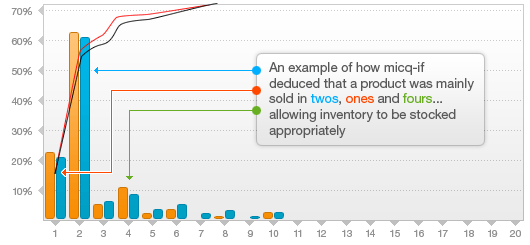If on average I sell 0.5 units per month when is an inventory level of one not the right answer?
Well it is when you sell commonly in ones …
 There are many products of course which are sold in ones. We might have two feet but we have one left foot and we have one right. We drive cars with one steering wheel. We usually buy one wallet, one handbag and one belt at a time. So yes, in these cases one may well be the right answer. But how often do our customers buy in quantities that suit our system’s abilities to calculate stock levels using such overly simple assumptions?
There are many products of course which are sold in ones. We might have two feet but we have one left foot and we have one right. We drive cars with one steering wheel. We usually buy one wallet, one handbag and one belt at a time. So yes, in these cases one may well be the right answer. But how often do our customers buy in quantities that suit our system’s abilities to calculate stock levels using such overly simple assumptions?
But it isn’t when your products are used in twos …
 So many products are bought and sold in twos. You don’t often buy one coffee mug. More often you buy one each for you and your partner. Cars have two front wheel disc brakes. Many kitchens have two sinks and therefore two plugs.
So many products are bought and sold in twos. You don’t often buy one coffee mug. More often you buy one each for you and your partner. Cars have two front wheel disc brakes. Many kitchens have two sinks and therefore two plugs.
Stocking one would clearly not be the right answer most of the time. One would be one too few. Three would be one too many. The stock level should perhaps be two, or for a higher usage product, four.
How often are your inventory levels out by just one? When you add up all the ones how much of your working capital are you wasting? In one typical customer branch we found that products sold commonly in quantities other than one represented nearly 30% of the stock (by product count and by value). Getting the levels right for such a large amount of stock can make a big difference to your balance sheet and your bottom line.
And it isn’t when your customers use the products four at a time …
 Many beds have four castors. Cars have four tyres (not counting the spare) and all four will often be replaced together, or at least often enough to be very inconvenient for the customer and a lost sales opportunity if there are only two in stock.
Many beds have four castors. Cars have four tyres (not counting the spare) and all four will often be replaced together, or at least often enough to be very inconvenient for the customer and a lost sales opportunity if there are only two in stock.
Of course in this case stocking one would be absolutely useless. In fact it would be worse than useless, because the inventory is adding to your cost of working capital without adding any value. And don’t expect pack sizes to solve the problem all the time. Your supplier sells them to you in 12s.
And sometimes it might be prudent to stock nothing at all ...
And if perhaps your forecast of 0.5 per month really means just half a dozen each year or a dozen every other year, then perhaps it is wiser to stock zero. The carrying cost might well overwhelm the need to immediately service a customer in this case. It might be more profitable to transfer the stock in, or pop it in an air-bag when required by the customer. This might just produce a better return on assets. It  would be nice of course if a system could help you determine when not to stock a low usage item like this, especially when you typically have tens of thousands of them.
would be nice of course if a system could help you determine when not to stock a low usage item like this, especially when you typically have tens of thousands of them.
And what about when the customer requires the product for preventive maintenance? They might be a mine or a factory planning a Christmas shut down. Perhaps the part is for a surgeon planning elective surgery in one month’s time. If there is time to ‘forward’ order the product for when it is actually needed, and that is the common scenario, then again, the right stock level may well be zero, even for a relatively high usage item.
So how can you make the right stocking decisions?
And what happens when you have a product that might be used in twos some of the time, fours another and perhaps even be sold in tens, 12s and even 20s, although rarely. Think about a set of car seat covers. For all four seats? Or just the two front ones? Spark plugs? Four, six or eight? It is important that you can easily determine what the most common frequencies are so that you can make prudent stock level decisions. And perhaps some markets buy in different quantities. A retail consumer might buy in twos, a small business in tens and a large remote business in 100s. Wouldn’t it be nice if you had something that helped you consider all these factors largely automatically?